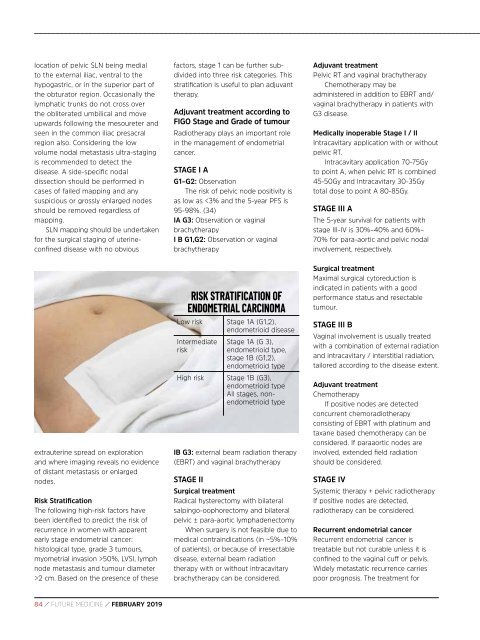You also want an ePaper? Increase the reach of your titles
YUMPU automatically turns print PDFs into web optimized ePapers that Google loves.
location of pelvic SLN being medial<br />
to the external iliac, ventral to the<br />
hypogastric, or in the superior part of<br />
the obturator region. Occasionally the<br />
lymphatic trunks do not cross over<br />
the obliterated umbilical and move<br />
upwards following the mesoureter and<br />
seen in the common iliac presacral<br />
region also. Considering the low<br />
volume nodal metastasis ultra-staging<br />
is recommended to detect the<br />
disease. A side-specific nodal<br />
dissection should be performed in<br />
cases of failed mapping and any<br />
suspicious or grossly enlarged nodes<br />
should be removed regardless of<br />
mapping.<br />
SLN mapping should be undertaken<br />
for the surgical staging of uterineconfined<br />
disease with no obvious<br />
factors, stage 1 can be further subdivided<br />
into three risk categories. This<br />
stratification is useful to plan adjuvant<br />
therapy.<br />
Adjuvant treatment according to<br />
FIGO Stage and Grade of tumour<br />
Radiotherapy plays an important role<br />
in the management of endometrial<br />
cancer.<br />
STAGE I A<br />
G1–G2: Observation<br />
The risk of pelvic node positivity is<br />
as low as 50%, LVSI, lymph<br />
node metastasis and tumour diameter<br />
>2 cm. Based on the presence of these<br />
RISK STRATIFICATION OF<br />
ENDOMETRIAL CARCINOMA<br />
Low risk<br />
Intermediate<br />
risk<br />
High risk<br />
IB G3: external beam radiation therapy<br />
(EBRT) and vaginal brachytherapy<br />
STAGE II<br />
Stage 1A (G1,2),<br />
endometrioid disease<br />
Stage 1A (G 3),<br />
endometrioid type,<br />
stage 1B (G1,2),<br />
endometrioid type<br />
Stage 1B (G3),<br />
endometrioid type<br />
All stages, nonendometrioid<br />
type<br />
Surgical treatment<br />
Radical hysterectomy with bilateral<br />
salpingo-oophorectomy and bilateral<br />
pelvic ± para-aortic lymphadenectomy<br />
When surgery is not feasible due to<br />
medical contraindications (in ~5%–10%<br />
of patients), or because of irresectable<br />
disease, external beam radiation<br />
therapy with or without intracavitary<br />
brachytherapy can be considered.<br />
Surgical treatment<br />
Maximal surgical cytoreduction is<br />
indicated in patients with a good<br />
performance status and resectable<br />
tumour.<br />
STAGE III B<br />
Vaginal involvement is usually treated<br />
with a combination of external radiation<br />
and intracavitary / interstitial radiation,<br />
tailored according to the disease extent.<br />
Adjuvant treatment<br />
Chemotherapy<br />
If positive nodes are detected<br />
concurrent chemoradiotherapy<br />
consisting of EBRT with platinum and<br />
taxane based chemotherapy can be<br />
considered. If paraaortic nodes are<br />
involved, extended field radiation<br />
should be considered.<br />
STAGE IV<br />
Systemic therapy + pelvic radiotherapy<br />
If positive nodes are detected,<br />
radiotherapy can be considered.<br />
Recurrent endometrial cancer<br />
Recurrent endometrial cancer is<br />
treatable but not curable unless it is<br />
confined to the vaginal cuff or pelvis.<br />
Widely metastatic recurrence carries<br />
poor prognosis. The treatment for<br />
84 / FUTURE MEDICINE / <strong>FEBRUARY</strong> <strong>2019</strong>


















